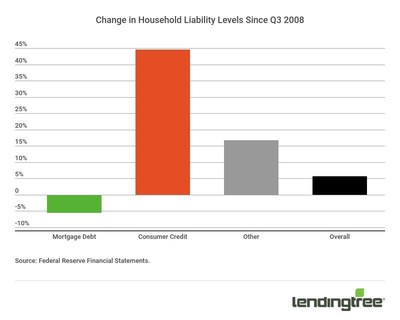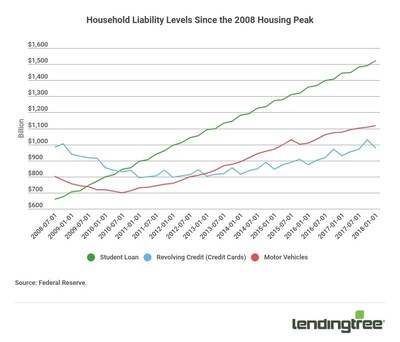CHARLOTTE, N.C., June 21, 2018 /PRNewswire/ -- LendingTree®, the nation's leading online loan marketplace, today released its Consumer Debt Outlook for June 2018, finding that American household debt is currently on pace to exceed the prior peak debt level from 2008 by the end of June, primarily due to non-mortgage consumer debt. LendingTree's analysis of the latest Federal Reserve data found that mortgage-related household debt has actually fallen by 5.5 percent while total consumer credit - a collection of revolving credit and installment loans - has increased by 45 percent, of which 42 percent is comprised of student debt alone.
Analysis Highlights
- American household debt is currently on pace to be $1 trillion above the peak debt level of 2008 by the end of this month. That figure has been increasing at a 3.4 percent annual rate and includes mortgage debt.
- Total mortgage and consumer debt levels are on pace to reach $15.7 trillion at the end of the second quarter, versus $14.7 trillion 10 years ago.
- Credit card debt, student loans and auto loans have increased by 45 percent over the past decade. Consumer debt (which excludes mortgages) is on pace to exceed $4 trillion by December 2018.
- Mortgages weigh less on American households than they have in recent years, even though they comprise the largest amount of debt. As measured by a percentage of disposable income, outstanding mortgages comprise less of a liability.
- Total student loan debt recently surpassed $1.5 trillion and comprises 42 percent of all consumer debt. That far exceeds the 27 percent share of debt credit card balances occupy. A decade ago, those percentages were reversed.
- While nominal total debt levels now exceed 2008 levels, households are much better situated to handle debt than they were a decade ago. Mortgage balances currently are around 68 percent of disposable income, and credit card balances are less than 7 percent of income. In 2008, balances were as high as 98 percent and 10 percent, respectively.
- One exception to the overall trend is millennials, who largely shoulder most of the growing student loan debt and are underrepresented in homeownership rates.
Household debt to surpass 2008 peak by $1 trillion
In the first quarter of this year, household net worth, as measured by the Federal Reserve Financial Accounts, reached $100 trillion for the first time. Assets — primarily financial instruments and real estate — gained more than $1.07 trillion in the first quarter, handily outpacing the additional debt Americans accumulated.
Nonetheless, liabilities have been steadily increasing in recent years. But unlike a decade ago, mortgages aren't the culprit. It is non-mortgage-related debt, such as student loans, credit card debt and auto loans, that have been growing. By the end of the second quarter 2018, we'll have $1 trillion more in household debt than we did in 2008 — and none of it is attributable to housing.
Since the third quarter of 2008, the peak of last decade's housing bubble, mortgage-related household debt has actually fallen by 5.5 percent. Meanwhile, consumer credit — a collection of revolving credit and installment loans, has increased by 45 percent.
Credit card balances still below 2008 levels; student loan debt levels continue to balloon
Consumer credit is a collection of a number of household liabilities — auto loans, credit cards and student loans are the three largest types. Of the three, student loan balances are growing the fastest — they've risen 130 percent since the housing crisis began. Compare that with auto loans, which have risen a much more modest 39 percent in the past decade. Credit card balances are actually slightly lower than they were in 2008, and that's before factoring in 10 years of inflation.
In other words, over the past decade, the burden of non-mortgage debt has shifted from credit card borrowers to student loan borrowers. Credit cards and student loans have switched places. In 2008, credit card debt comprised 40 percent of household liabilities, and student loan debt made up 27 percent. Today, those shares are swapped — student loans make up 42 percent of the nation's household debt, and credit cards are now only 28 percent of the share.
But no matter the mix, the trend is definitely more debt. LendingTree analysts project that total consumer debt (excluding mortgage debt) will exceed $4 trillion by the end of 2018.
Income gains are mitigating the increase for most; millennials are an exception
Although total household debt has returned to 2008 levels, the difference in 2008 and today's income and types of debt are significant.
Most important, mortgage balances as a percentage of disposable personal income has fallen from a high of 98 percent in 2008 to 68 percent as of the latest quarter. In other words, homeowners today, on average, have significant equity in their homes. Ten years ago, equity was virtually nonexistent.
Similarly, credit card debt, as measured as a percentage of income, has fallen by about 30 percent versus the levels they were at a decade earlier. Credit card balances represent about 6.6 percent of income as of the first quarter of 2018; a decade ago, it was nearly 9 percent.
At the other end of the spectrum, student loan borrowers are shouldering nearly 70 percent more than they were a decade ago, as student loans now represent 10.3 percent of disposable income, versus 6 percent a decade ago.
As millennials bear most of this student loan debt while remaining underrepresented in homeownership versus other age cohorts, the economic distress of millennials becomes much more understandable, at least on a relative basis, and relating specifically to debt burdens.
To view the full report, visit: https://www.lendingtree.com/finance/consumer-debt-report-june-2018/.
About LendingTree
LendingTree (NASDAQ: TREE) is the nation's leading online loan marketplace, empowering consumers as they comparison-shop across a full suite of loan and credit-based offerings. LendingTree provides an online marketplace which connects consumers with multiple lenders that compete for their business, as well as an array of online tools and information to help consumers find the best loan. Since inception, LendingTree has facilitated more than 65 million loan requests. LendingTree provides free monthly credit scores through My LendingTree and access to its network of over 500 lenders offering home loans, personal loans, credit cards, student loans, business loans, home equity loans/lines of credit, auto loans and more. LendingTree, LLC is a subsidiary of LendingTree, Inc. For more information go to www.lendingtree.com, dial 800-555-TREE, like our Facebook page and/or follow us on Twitter @LendingTree.
MEDIA CONTACT:
Megan Greuling
704-943-8208
[email protected]
SOURCE LendingTree
Related Links
WANT YOUR COMPANY'S NEWS FEATURED ON PRNEWSWIRE.COM?
Newsrooms &
Influencers
Digital Media
Outlets
Journalists
Opted In


Share this article